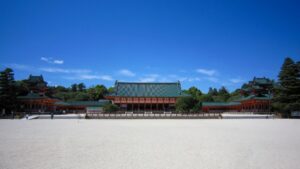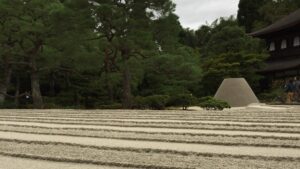Kinkakuji Temple (Golden Pavillion), Represents, from the top down, Buddhism, Samurai, and Court Nobles
Kinkakuji Temple (Golden Pavillion) - a World Heritage Site - is a reliquary hall of Rokuon-ji Temple built by the third shogun of the Muromachi Shogunate (1336-1573), Ashikaga Yoshimitsu, after handing the position of Shogun over to his son and assumed a Buddhist priest. The third floor is a Zen Buddhist monastery with several rounded windows, the second floor is the common residence style of Samurai with a simple sliding wooden door, and the first floor is the typical residence of the aristocracy for court nobles called Shinden-zukuri style with Shitomito (hinged plank doors). Why did Yoshimitsu build the Kinkakuji in such a way that each floor was a different type of architecture? One theory says that it expresses Yoshimitsu's remarkable power, as he held dominion over the imperial court and the shogunate.
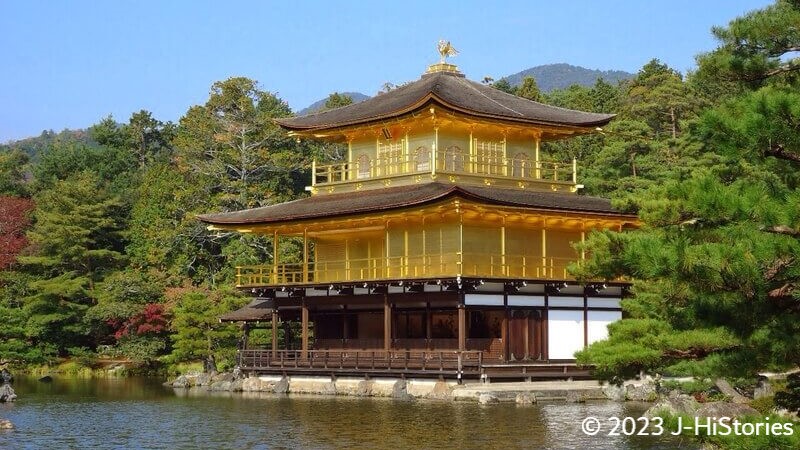
Inaugurated as Shogun Amidst the Upheaval of the Northern and Southern Courts
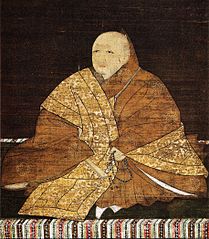
Amidst the tumultuous period of the Southern and Northern Courts (1336-1392), Ashikaga Yoshimitsu (1358-1408, 足利義満) was appointed the third shogun at the tender age of only 10 in 1369, while the upheaval was still unfolding. His grandfather, Ashikaga Takauji (1305-1358, 足利尊氏), overthrew the Kamakura Shogunate (1185-1333) at the request of the 96th Emperor Go-Daigo (1288-1339, 後醍醐天皇), and the Emperor's parental rule began. However, it collapsed just three years later because of this misrule. Emperor Go-Daigo fled from Kyoto down to mountainous Yoshino in Nara prefecture with the three sacred treasures and established the Southern Court. Meanwhile, Takauji built the Northern Court by setting up another emperor in Kyoto. The unprecedented Northern and Southern Courts began, with the existence of two emperors. Takauji then became a shogun himself and established the Muromachi Shogunate. However, as long as the Southern Courts existed, the warfare showed no signs of abating. This was when Yoshimitsu took the political stage.
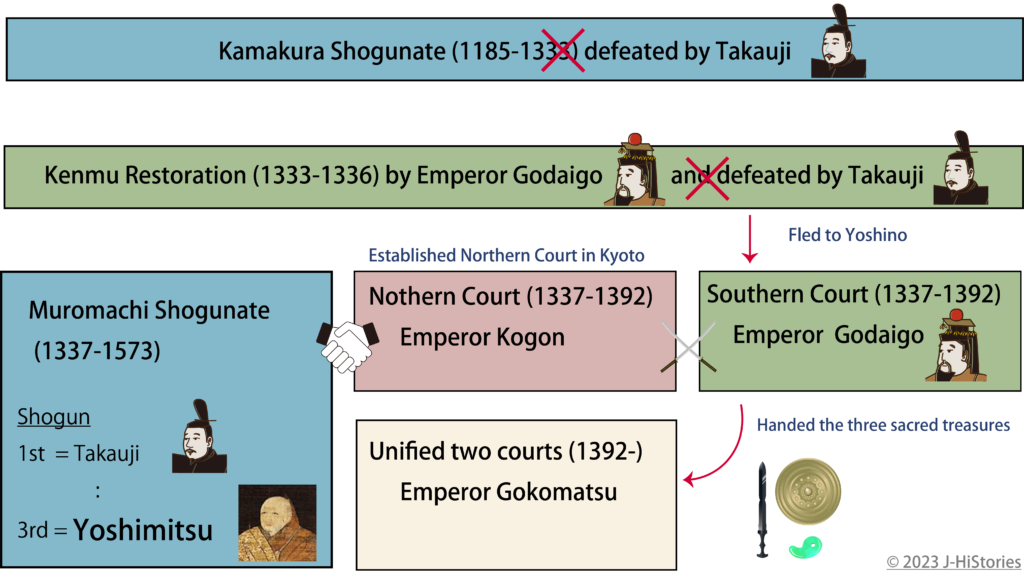
The Strategic Approach to Unify the Southern and Northern Courts
Despite the shogunate’s existence, it was far from monolithic, as power struggles persisted among various factions. While some forces aligned with the Southern Court, others lent their support to the Northern Court. Consequently, the battles remained unresolved for nearly four decades. Recognizing the necessity to quell domestic unrest, Yoshimitsu believed eliminating the Southern Court was the key. Nevertheless, prior peace endeavors had encountered persistent challenges in the mountainous region of Yoshino, which housed the imperial palace of the Southern Court.
Therefore, Yoshimitsu tried to unify the two Courts in three steps. Firstly, to dominate the Northern Court, then, to control the entire samurai by eliminating the powerful samurai clans and eliminating the supporters of the Southern Court, and finally to persuade the Southern Court to resign. For this, he seized power over the imperial court of the Northern Court by implementing strict reforms. Upon assuming the esteemed position of “Ukon-no-e-Daisho” (Major Captain of the Right Palace Guards) in 1378, he orchestrated a ceremonial display of gratitude to the emperor for this appointment. The grand procession, which included 21 court nobles, departing from the newly constructed "Hana-no-Gosho" (the Shogunate office and Yoshimitsu's residence), left an indelible impression on the populace of Kyoto, portraying Shogun Yoshimitsu not only as a ruler of the samurai but also the court nobility. Next, he began to reduce the power of the powerful samurai like the Toki and Yamauchi clans. Through these efforts, he succeeded in consolidating authority over the powerful clans. With no more factions supporting the Southern Court, they acceded to Yoshimitsu's peace terms, handing the three sacred treasures to the Northern Court. This momentous event marked the unification of the Northern and Southern Courts
Dogi, the Ruler Transcended the Power of the Imperial Court and the Shogunate
In 1395, Yoshimitsu relinquished the position of Shogun to his son and assumed the role of a Buddhist priest named Dogi. He built and resided in Kinkakuji, modeled after Saihoji Temple, in the serene Kitayama area northwest of Kyoto. Yoshimitsu’s shift in roles did not diminish his influence over state politics. With unwavering support from his samurai and couriers, he remained a central figure in the affairs of the state, orchestrating matters from the Kinkakuji. One of his remarkable contributions was the initiation of trade with the Ming Dynasty, an unprecedented endeavor in over 500 years, conducted under his new identity as Dogi. This groundbreaking trade led to immense profits for the shogunate and the entire nation. In addition, the elegant and dazzling Kitayama culture flourished, giving rise to various artistic achievements. Among these, the Noh play (a World Intangible Heritage) reached its perfection through Zeami whom Yoshimitsu patronized generously. Furthermore, he set the Kyoto Five Zen temples: Tenryuji, Shokokuji, Kenninji, Tofukuji, and Manjuji Temples. In addition, Nanzenji temple (exceptional).
The Sense of the World Yoshimitsu Reached
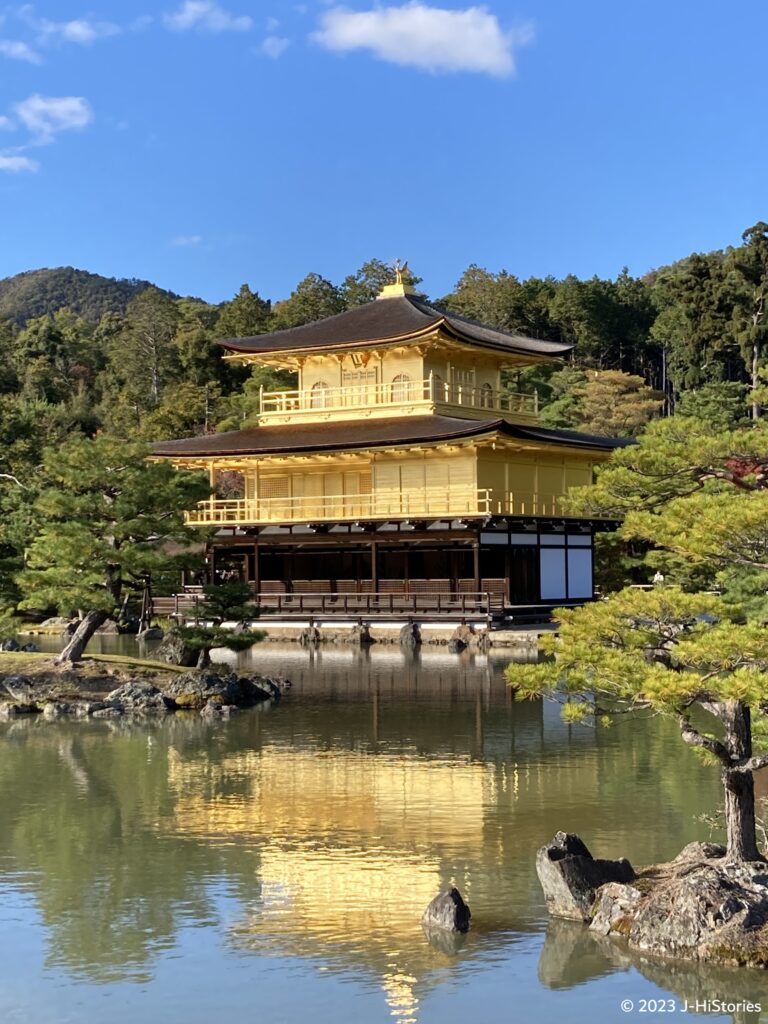
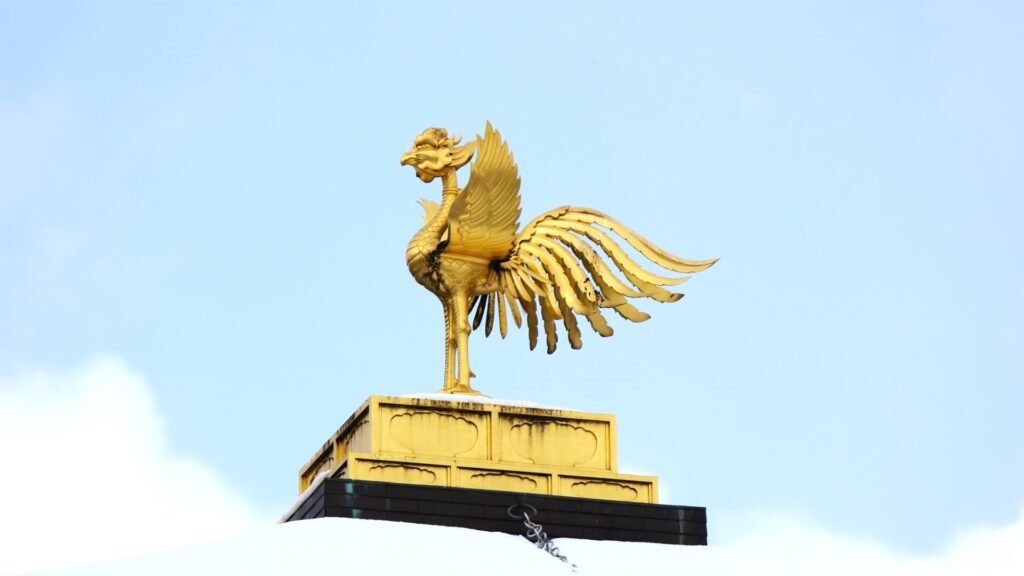
Enjoy a captivating stroll through the picturesque Kinkakuji while reflecting on Yoshimitsu’s remarkable achievements in uniting the Southern and Northern Courts, putting an end to turbulence, fostering national peace and prosperity, and flourishing Kitayama Culture. The "Phoenix" statue on the top is a symbol of eternal life, power, and the desire for a peaceful world without warfare. Yoshimitsu stood at the top of Samurai and Court Nobles as a Buddhist priest. Therefore, the architecture of Kinkakuji had to be, from top to bottom, the Buddhist style (Dogi), the samurai style (Shogun Yoshimitsu), and the courtly aristocratic style (Grand Minister Yoshimitsu). During the prime of the Muromachi Shogunate, his influence was unparalleled. But, in the era of his grandson, Yoshimasa (1436-1490足利義政), the shogunate’s power declined and he built Ginkakuji Temple (Silver Pavilion) as if he escaped from politics. That is one of three Great Pavilions of Kyoto (Gold, Silver, and Hiun). The majesty of Kinkakuji shining in the setting sun, its glow reflected in the pond, creates an otherworldly atmosphere. Perhaps the state that Yoshimitsu reached after all his hard work was the Pure Land, like this scene.
Ashikaga Yoshimitsu Timeline
| 1185 | Minamoto Yoritomo established Kamakura Shogunate | - | Kamakura period |
| 1333 | The fall of Kamakura Shogunate/The Kenmu Restoration had begun | - | |
| 1336 | The Kenmu Restoration collapssed / Emperor Go-Daigo established the Southern Court at Yoshino | - | Kenmu Restoration |
| 1336 | Ashikaga Takauji estabilished Muromachi Shogunate | - | |
| 1338 | Ashikaga Takauji became Shogun of Muromachi Shogunate | - | Muromachi period |
| 1358 | Ashikaga Yoshimitsu was born | Age =1 | |
| 1367 | Yoshimitsu suceeded to Ashikaga family lineage | 10 | |
| 1369 | Yoshimitsu became the 3rd Shogun of Muromachi Shogunate | 12 | |
| 1378 | Yoshimitsu constructed Hana-no-Gosho | 21 | |
| 1378 | Yoshimitsu assumed Ukon-no-e-Daisho | 21 | |
| 1379 | Yoshimitsu defeated the Toki clan | 22 | |
| 1391 | Yoshimitsu defeated the Yamana clan | 34 | |
| 1392 | The unification of the Southern and Northern Courts | 35 | |
| 1395 | Yoshimitsu became a Buddhist priest | 38 | |
| 1397 | Golden Pavillion was constracted | 40 | |
| 1399 | Yoshimitsu started governmental jobs at Kitayama(Tenkyokaku) | 42 | |
| 1404 | Yoshimitsu started the trade with Min | 47 | |
| 1408 | Yoshimitsu passed away | 51 |
Recommendation to visit
Kinkakuji Temple(Golden Pavillion)
- Access: 45 minutes from Kyoto Station. Take bus #205 at B3 bus stop bound for "Kitaoji BT (北大路バスターミナル)". Got off "Kinkakuji-michi (金閣寺道)" stop. A five-minute walk.

